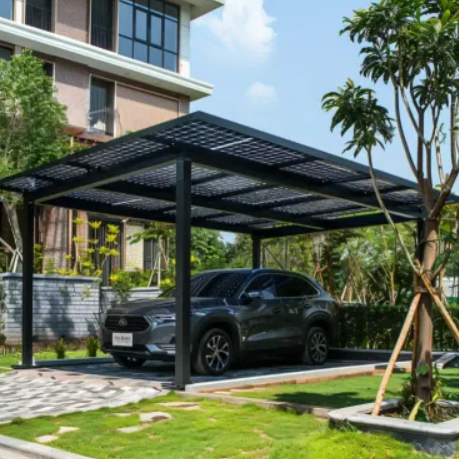### Ավանդական Foto voltaic տեխնոլոգիաներ սոլար պարկինգ կառուցվածքներում
Երկուկողմանի արևակայան անունները արժեքավոր էներգիայի հավաքման համար
Երկուկողմային սոլար տախտերը փոխեցին խաղաղությունը էներգիայի հաջորդաբար հավաքման մեջ, ինչպիսիք են սոլար պարկինգ-ները։ Այս ավանդական տախտերը կարող են հավաքել արևի ճառագայթումը երկու կողմերից, և դրանք կարող են ավելացնել էներգիայի արտադրությունը մինչև 27%-ով, համեմատաբար սովորական միակողմային տախտերի հետ։ Երկուկողմային տախտերի աշխատանքը դեռևս լավագույն է սոլար պարկինգ-ների տակ, որոնց տարածքում հաճախ գոյություն ունեն արևականությունը վերացնող մակերևույթներ, որոնք սահմանում են լավագույն արևի ճառագայթումի և այն փոխարինելու հնարավորություն։ Այս տեխնոլոգիան նշանակալիորեն բարձրացնում է իր էներգիայի արդյունավետությունը, անցնելով սոլար պարկինգ-ներին ավելի վատակավոր տարբերակ արժեքների և մասնակցության համար։ Հետևաբար՝ հողի մակերևույթը, կամ նրանց կողքերում գտնվող դիրունքները, կամ ավտոմոբիլի տագանի մակերևույթը կարող են լինել արևականությունը վերացնող մակերևույթներ՝ արևի ճառագայթումի ավելացման համար։
Երկնիշ սոլարային լուծման ինտեգրացիա՝ սոլարային պարկինգների մեջ, ավելի բարդ դարձնում է դրանց հնարավորությունը, իսկ նաև տարածում է կանխավճարների պատճառով։ Այն ավելի շատ էներգիա արտադրելու հնարավորությամբ նույն տարածքում, երկնիշ սոլարային տախտերը բացատրում են ավելի կանխավճար համարիչ՝ բարեկարգ պահանջի համար հարմարագործելու համար և օգնում են կարбոնային հետքերի նվազեցման համար։ Հաճախակից սպասարկող նախագիծների և կանոնականության դարձնելու հետ ավելի հասարակ լուծումների վերաբերյալ, երկնիշ սոլարային տախտերը բացատրում են միակ լուծում ավելի երկար էներգիայի արտադրության համար փոքր տարածքում՝ ցույց տալով սոլարային պարկինգների դերը այդպիսի կանխավճար համակարգի զարգացման մեջ։
Պերովսկիտային սոլար ցելլեր և ավելացված արդյունավետություն
Պերովսկիտային սոլարային ցելլերը դառնացին այսօրի պարտադիրները ֆոտովոլտային տեխնոլոգիայի մեջ՝ և հիմա, գիտնականների խումբ ուսումնասիրում է ճանաչող եղանակներ դրանց ավելի արդյունավետ դարձնելու: Հատուկ արդյունավետություն, շեղելիություն և abl-ի հատկությունները դարձնում են նրանց ամենաքիչը հետաքրքիր համակարգերի համար սոլարային գանգացուցիչների լուծումներում ինտեգրելու: Պերովսկիտային ցելլերը ք },{ են և կարող են ինտեգրվել լայն տեսականի օգտագործումներում, առանց նշանակալի կառուցավոր բարդության կունենալու:
Պերովսկիտ սոլարային ցेलերի պահանջը, որովհետև դրանք առաջանում են, ցույց է տալիս, որ շուտ կարող է գալ ժամանակը, երբ ստիպեցված արժեքով սոլարային ցելերը կդառնան օգտագործելի այլ գործարաններում, ինչպիսիք են սոլարային գarezները։ Գումարությունը՝ դարձնելով դրանք և արժեքավոր և բարձր արդյունավետությամբ, կարող է փոխել սոլարային տեղադրումները՝ դարձնելով դրանք ավելի մոբիլ և առաձգական։ Պերովսկիտ ցելերի առավելությունները համապատասխանում են գործարանի ընդհանուր տendency-ին՝ բարելավելու հարցազրույցների օգտագործումը և նվազեցնելու միջավայրային կատարումը, դրանք դարձնում են iconic տարրեր սոլարային գarezների կառուցվածքի ապագա զարգացման մեջ։
Պերովսկիտ սոլարային ցելերը կհամագործակցեն աճող պահանջին համար հասարակության և վերանորոգելի էներգիայի տարբերակներին, այնպես որ արդյոք արդյոք արդյոք արդյոք արդյոք արդյոք արդյոք արդյոք արդյոք արդյոք արդյոք արդյոք արդյոք արդյոք արդյոք արդյոք արդյոք արդյոք արդյոք արդյոք արդյոք արդյոք արդյոք արդյոք արդյոք արդյոք արդյոք արդյոք արդյոք արդյոք արդյոք արդյոք արդյոք արդյոք արդյոք արդյոք արդյոք արդյոք արդյոք արդյոք արդյոք արդյոք արդյոք արդյոք արդյոք արդյոք արդյոք արդյոք արդյոք արդյոք արդյոք արդյոք արդյոք արդյոք արդյոք արդյոք արդյոք արդյոք արդյոք արդյոք արդյոք արդյոք արդյոք արդյոք արդյոք արդյոք արդյոք արդյոք արդյոք արդյոք արդյոք արդյոք արդյոք արդյոք արդյոք արդյոք արդյոք արդյոք արդյոք արդյոք արդյոք արդյոք արդյոք արդյոք արդյոք արդյոք արդյոք արդյոք արդյոք արդյոք արդյոք արդյոք արդյոք արդյոք արդյոք արդյոք արդյոք արդյոք արդյոք արդյոք արդյոք արդյոք արդյոք արդյոք արդյոք արդյոք արդյոք արդյոք արդյոք արդյոք արդյոք արդյոք արդյոք արդյոք արդյոք արդյոք արդյոք արդյոք արդյոք արդյոք արդյոք արդյոք արդյոք արդյոք արդյոք արդյոք արդյոք արդյոք արդյոք արդյոք արդյոք արդյոք արդյոք արդյոք արդյոք արդյոք արդյոք արդյոք արդյոք արդյոք արդյոք արդյոք արդյոք արդյոք արդյոք արդյոք արդյոք արդյոք արդյոք արդյոք արդյոք արդյոք արդյոք արդյոք արդյոք արդյոք արդյոք արդյոք արդյոք արդյոք արդյունավետությունը դարձնելու համար՝ դարձնելով դրանք «թանկ» և «անհարմար»։
Ինտեգրացիա Electric Vehicle Charging Infrastructure-ի հետ
Արևակարգային EV Վառելիքների Ստացիոնարներ
արևակայան EV ստուգման վարձակերպություններ ներկայացնում են կանաչ ճանապարհ էլեկտրամոբայլերի համար և ենթադրում են մեծ ներդրում էներգիական անկախության դեպքում։ Այդ վարձակերպությունների միացումը արևակայան ավտոմեքենատանների հետ թողնում է օգտագործել էլեկտրականությունը և ուժը, որը գեներացնում ենք ճանապարհով ստուգման կետում՝ ավելի կառուցվածքային և ուժավոր եղանակով, ինչպես նաև իրականացնում է շատ ցածր էներգիայի արժեք։ Թվերը նաև ցույց են տալիս, որ արևակայան ստուգման համար կարբոնային արտադրությունները կարող են դրամատիկ ձախողել այն մակարդակից, որոնք արդյունավետ ցանցային ստուգման եղանակներով արտադրվում են։ Այս կրկնակի արժանգը՝ կանաչ էներգիայի տարածումով և ստուգման վարձակերպություններով, փոխարինում է արևակայան ստուգման EV-ն քանի հայտնի տեխնոլոգիայի համար goedeնական տարածքներ, գրավական պարկեր և այլ հայտնի պարկեր։
Երբ դուք խոսք եք հանդիսացնում արևակայան EV լավագույն ստացիոնարների մասին, մտածեք այն համակարգային փոփոխության մասին, որը ներկայացնում է՝ մեր կախումից նվազեցնելու համար անհաղորդ էներգիակայաններից և համապատասխանելու համար կարողացող տրանսպորտին: Արևակայան մաշկավազների և EV լավագույն համակարգի միջոցառումները ավելի լավ դարձնում են արևի արժեքային առաջարկը, և ստիգում են պահանջը ավելի կաթար և կանաչ էլեկտրամոտորային մեքենաների համար: Սակայն, հաճախորդականության ավելացման հետ էլեկտրամոտորային մեքենաների ուղղությամբ, կարծում եմ, այսպիսի համակարգային լուծումների, ինչպիսին է արևով աստիճանացված լավագույն ստացիոնարները, պետք է դարձնեն ավելի հայտնի։
Մեքենա-ցանց (V2G) տեխնոլոգիայի ինտեգրացիա
Վարունքից-ցեղ (V2G) նոր գաղափար է էներգիայի վարկածում, շնորհիկրան որի դեպքում դրանց էներգիայի արտահանումը կարող է փոխարինվել էներգիայի ներբեռնումով ցեղին, թույլատրելով ավելի լավ վարկած։ Սոլար մասնաճյուղների հետ միացած V2G-ն կարող է օգնել պակասել բարձր բեռների ժամանակներում միջոցով՝ արտահանելով պարկված մեքենաներում պահված էներգիան։ Այս ոլորտում կատարվող հետազոտություններ ցույց են տալիս, որ V2G համակարգերը կարող են նպաստել ցեղի կայունությանը և համարենելի էներգիայի օգտագործմանը։ Այս փոխադարձությունը կարող է լինել կարևոր համարենելի էներգիայի տարածումի մասշտաբավորման տարբեր սեկտորներում, քանի որ այն համոզում է էներգիայի բաշխման ցանցերի օպտիմիզացիային։
V2G-ի ինտեգրացիա սոլար կարպորտներում չի միայն օգնում կայանականությունը կայողանալ, այլև հնարավորություն է տալիս EV անդամներին ստեղծել արժույթային մոդելներ՝ վաճառելով գումարված էներգիան վերադարձ կայանակին: Սա ունի մեծ նշանակություն էներգիայի հավասարության համար, քանի որ փորձում ենք կախվել ավելի շատ հարթակային կարգերից: V2G-ի և սոլարի համատեղելիությունը թույլ է տալիս պատահարական միջոց լուծելու էներգիայի խնդիրները և պարզապես մաքսիմալիզելու ռեսուրսները: Երբեմն հնարավորությունները ենթադրում են ավելի լավ էներգիական հաստատություն և ցանկացած սպառողներին ցանկացած էներգիայի արժեքները նվազեցնելու հնարավորությունը՝ ինչը դեռևս դիմադրում է նոր էներգիայի միջավայրում:
Արևասեղանային Համակարգեր Սեղման և IoT-Enabled
Իրական Ժամանակի Էներգիայի Նախագծում և Կարգավորում
Ինտերնետով ապահովված սոլար գինjalների միջոցով, էներգիայի հետ կապված համոզումը փոխվել է, քանի որ դրանք բարձրացնում են իրական ժամանակի տեղեկատվությունները էներգիայի օգտագործման և արտադրման մասին, ինչպես օգնում է օգտագործել սոլար էներգիայի առավել արդյունավետ օգտագործումը։ Այս գործիքը հիմք է ավանդական էներգիայի հաստատության համակարգերի համար, որոնք թույլ են տալիս հետևել էներգիայի հոսքերին և գտնել էներգիայի օգտագործման անկանոնություններ։ Օգտագործելով անալիտիկա, այն կարող է ցույց տալ օգտագործողներին, երբ պետք է արժեքավորել, երբ օգտագործել էլեկտրոնային էներգիան կամ երբ պահել հետո օգտագործելու համար՝ կրճատելով արժեքները և բարձրացնելով արդյունավետությունը։ Գործնական կիրառումը իրական ժամանակի հետ համատեղելու համակարգին ցույց է տվել, որ հասնում են 20%-ի էներգիայի խանգիտությանը, որը ունի նշանական կարևորություն տնային և կոմերցիալ օգտագործման համար, ցույց տալով նրա արդյունքների համար համեմատելի նշանակություն։ Տեխնոլոգիայի փոփոխությունների հետ միասին, IoT համակարգերը կդառնան մաս սոլար գինjalների դիզայնից, և կարող են տարածել տվյալների հատորները՝ ավելի արդյունավետություն և անկախություն ստանալու համար։
AI-ի հետ աշխատող պրոգնոստիկական մատագային լուծումներ
Արհեստական ինտելեկտի (ԱԻ) վրա հիմնված կանխատեսողական սպասարկումը թույլ է տալիս ավելի ակտիվ կերպով կառավարել արեւային կայանատեղերը՝ կանխատեսելով հնարավոր խնդիրները և առաջարկելով միջամտություններ: Բարդ ալգորիթմների շնորհիվ, արհեստական ինտելեկտի (ԱԻ) օգնությամբ հնարավոր է մշակել շահագործման հսկայական ծավալներով տվյալներ՝ բացահայտելով վաղ ցուցանիշներ բաղադրիչների վնասվածքների կամ անընդունելիության մասին: Այս ակտիվ սպասարկումը նվազեցնում է դադարները, երկարացնում է արեւային կայանատեղերի կյանքը և ապահովում է անընդհատ էլեկտրական հզորության արտադրությունը: ԱԻ տեխնոլոգիաները տրամադրում են գործնական հետադարձ կապ համակարգի արդյունավետության բարելավման, տեղեկացված որոշումներ ընդունելու և արդյունավետ արժեքով համակարգի սպասարկման համար: Ըմբռնումները, որոնք օգտագործում են ԱԻ-ի վրա հիմնված սպասարկման ծրագրեր, տեսնում են նվազած նորոգման ծախսեր և ճկուն սպասարկման ժամացուցակներ, ինչը ապացուցում է, որ ԱԻ-ն անհրաժեշտ բաղադրիչ է արեւային ենթակառուցվածքների կայունության և հուսալիության ապահովման համար: Այս նորամուծությունները շեշտում են արեւային կայանատեղերին հեռատես տեխնոլոգիաներ ինտեգրելու և էներգետիկայի ավելի հեռատես ապագայի ուղղությամբ շարժվելու կարիքը:
Դարձնող նյութեր և մոդուլային դիզայնի նորություններ
Վերականգնելի և սպաստացի կառուցման նյութեր
Կարևոր է օգտագործել վերակիրառելի արտադրանքներ սոլար կարպորտի կառուցման ժամանակ, որպեսզի նվազեցնենք շրջապահաբանական ազդեցությունները և աջակցենք կարողանությունը։ Վերակիրառելի արտադրանքների կամ նոր արտադրանքների ստեղծման հնարավորության օգտագործմամբ մենք նվազեցնում ենք սոլար կարպորտի համակարգերի կապոնելիության հետ կապված углекислый աispersությունը։ Երկրորդապես, անկախ կառուցվածքային նյութերից հեռացնելով, սեփականությունների և ժամանակի արդյունավետությունը ավելացնում է, իսկ կառուցվածքային ստրեսը նվազում է, ինչը կարող է ունենալ դրական ազդեցություն կիրառման արժեքների վրա։ Սպառողական վարքերի սովորությունների վերլուծությունը ցույց տվել է, որ .GREEN նյութը ձգում է սպառողները, որոնք համարում են շրջապահաբանական պարտադիրություններին՝ արդյունավետությունը ավելացնելով ավարտական արժեքներում։
Պատահական և մասշտաբավոր գարաջի կառուցումներ
ՊՐԵՖԱԲՐԻԿԱՏ ՍՈԼԱՐ ԿԱՐՊՈՐՏ ԴԵԶԱՅՆԵՐԸ ԱՇԽԱՏԱՑՈՒԹՅԱՆ ՀԵՏԱՎՈՐ ԾԱՂixmap ԱՐ Morm արդյոք համեմատված է դաշնակցությամբ առավել պարզ սարքի ժամանակի և աշխատանքի։ Այս արդյոք տեխնիկան համապատասխանում է աճող գործընթացին՝ սոլար տեղադրությունների արագ տեղադրման համար։ Ավելի նաև, այդպիսի կարպորտի դեզայնի մոդուլային բնույթը օգնում է գործունեություններին անցնելու դրանց ֆոտովոլտային համակարգի աճումը՝ համապատասխանաբար իրենց EV համար սարքի անհրաժեշտության աճման հետ։ Գործնականության աղբյուրներից հայտնի է, որ մոդուլային կարպորտները կարող են նվազեցնել ընդհանուր պրո젝տի ժամանակը մինչև 30%-ով, ինչը ներկայացնում է մատչելի լուծում գործունեություններին, որոնք պատրաստվում են պատրաստվելու ապագային օգտագործման պահանջներին։
Ստիմվացիայի ծրագրեր ավարտական և բնակավար ներդրումների համար
Սոլարային պարկինգները նաև համեմատվում են պետության և շтատի հաստատությունների կողմից ինքենդիվանդ ծրագրերի միջոցով, որոնք բաժանում են վճարումներ և գրանցումների նվազեցում, նվազեցնում է տեղադրման expanses-ը: Այս փորձարկումները նպաստում են սոլարային տեխնոլոգիան բոլորին, ներառյալ գործնականներին և տնտեսուններին: Այս ինքենդիվանդները ունենում են ֆինանսական ուժ սպասարկողներին, ինչպես տվյալները Renewable Energy Associations-ից ցույց է տալիս՝ սոլարային տեղադրումների 50%-ի աճ տարածքներում, որոնք ավանդականորեն համեմատում են այս ծրագրերին: Այս աճի հաստատությունը ցույց է տալիս կառավարության հետագա համեմատության ուժը համարյալ էներգիայի համար, որը կարևոր է օգնելու համար կառավարել կանաչ տնտեսական վերականգնում:
Նորությունների を超えումներ և Քաղաքական Սոլար Ծրագրեր
Սոլարային գարաջները նաև նոր սահման են սոլարային տեխնոլոգիայի համար զբաղված շուկաներում, մասնավորապես անենդունակ էներգիայից դնելով քաղաքացված տարածքներում։ Քաղաքների ավելիությամբ ստորագրված էներգիայի ազատության հետ, քաղաքները սկսել են զարգացնել քաղաքացի սոլարային ինֆրաստրուկտուրային գործունեություններ՝ փոխարինելով օգտագործելի իրավացի տարածքը սոլարային տեղադրումների համար, որոնք անցնում են ավելի հասարակ էներգիայի առանձնացված համարարկումներին։ Սոլարային գարաջների տնտեսական կարևորություն։ Ҹրագրումները ցույց են տվել, որ այդպիսի գործունեություններից առաջացած լայն տիրույթի ավելացուցակային հատուկությունները, ինչպիսիք են աշխատանքային վարժությունները և ավելի լավ էներգիայի անվտանգությունը, օգնում են դարձնել սոլարային գարաջները շատ առավել տարածված գործունեություն։ Ենթադրվող էներգիայի բացակայության և էներգիայի կրիզիսի խնդիրների հանգեցմամբ, զբաղված ենդունակ երկրները հիմա դիտարկում են սոլարային գարաջները որպես կենտրոնական մաս նոր քաղաքացի պրոեկտների դիզայնի համար՝ համապատասխանում ավանդական համարարկություններին։ Այս մոտեցումը ոչ միայն համապատասխանում է գլոբալ էներգիայի նպատակներին, այլ նաև ստեղծում է նոր քաղաքացի դիզայնի հավատալիքներ։
Հաճախ տրամադրվող հարցեր
Ինչ են կոչվում երկուկողմանի արևակից անոթները?
Երկուկողմանի արևակից անոթները անոթների տեսակ են, որոնք կարող են արևի լույս հանձնել երկու կողմերից, արևակից հանձնման արդյունավետությունը ավելի շատ դարձնելու համար, ինչպես նաև արդյունավետությունը մասնավորապես արդյունավետ է արևակայան միություններում .
Ինչպես է տարբերվում պերովսկիտային արևակից հցանցիկը تقليստ հցանցիկներից:
Պերովսկիտային արևակից հցանցիկները ավելի ադաման են, քիչ ծավալով են և առաջարկում են շեղում և 軽量 특성을 համեմատելիս սիլիկոնային հցանցիկների հետ:
Երբ և թերի կապել EV լաదարանները արևակից գնացքային տանձերով:
EV լադարանների կապումը արևակից գնացքային տանձերով թողնում է հնարավորություն ստեղծել տեղական էներգիայի գեներ, բարձրացնելով ադամանությունը և նվազեցնելով կախվածությունը սովորական ցանցից, որը նվազեցնում է углеродային արտադրությունը:
Բովանդակության աղյուսակ
- Երկուկողմանի արևակայան անունները արժեքավոր էներգիայի հավաքման համար
- Պերովսկիտային սոլար ցելլեր և ավելացված արդյունավետություն
- Ինտեգրացիա Electric Vehicle Charging Infrastructure-ի հետ
- Արևասեղանային Համակարգեր Սեղման և IoT-Enabled
- Դարձնող նյութեր և մոդուլային դիզայնի նորություններ
- Ստիմվացիայի ծրագրեր ավարտական և բնակավար ներդրումների համար
- Նորությունների を超えումներ և Քաղաքական Սոլար Ծրագրեր

